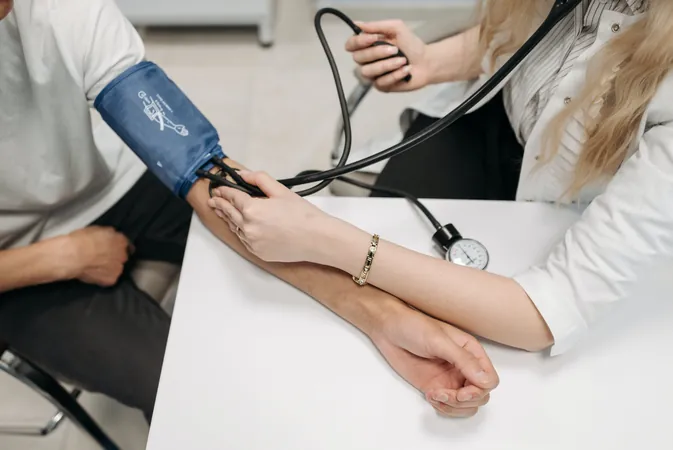
Revolutionary Two-Medication Combo Pill Shows Promise in Lowering Blood Pressure for Millions in India
2024-11-18
Author: Jacques
Groundbreaking Study on New Two-Medication Pill
A groundbreaking study presented at the American Heart Association's Scientific Sessions 2024 has unveiled significant results regarding a new two-medication combination pill designed to tackle the alarming rates of high blood pressure among adults in India. This innovative approach, which was shared on November 17, showcased its effectiveness in safely reducing blood pressure levels.
High blood pressure, or hypertension, is a pressing global health concern, with approximately 300 million individuals in India affected by this condition, in addition to nearly half of the adult population in the United States. While international guidelines have long recommended combining various blood pressure-lowering medications, this recent research has taken a closer look at which combinations yield the best outcomes, particularly for South Asian populations.
Expert Insights on Hypertension Management
Dorairaj Prabhakaran, M.D., the lead author of the study and a prominent cardiologist in India, emphasized the critical need for effective hypertension management, particularly in South Asian communities where the risk of stroke and cardiovascular diseases is worryingly high. "Optimal blood pressure management is essential to lower the cardiovascular complications of high blood pressure," he stated.
Details of the Clinical Trial
The clinical trial, known as the TOPSPIN study, included nearly 2,000 adults from diverse backgrounds in India, randomly assigned to receive one of three types of combination pills. Each pill paired two out of three widely recommended medications: a renin-angiotensin enzyme inhibitor (perindopril) to prevent arterial narrowing, a calcium channel blocker (amlodipine) that relaxes muscle in the heart and blood vessels, and/or a diuretic (indapamide) that aids in removing excess salt and water from the body.
Impressive Outcomes After Six Months
Remarkably, after just six months of treatment, results showed that all three combinations were equally effective, with about 70% of participants achieving blood pressure readings below the target of 140/90 mm Hg. Furthermore, over 40% reached even stricter levels with readings below 130/80 mm Hg.
Not only did participants experience significant reductions in blood pressure—approximately 30/14 mm Hg when measured in a doctor's office and 14/8 mm Hg through 24-hour ambulatory monitoring—but the safety profile of the medications was also impressive, with less than 3% of participants discontinuing treatment due to side effects. Interestingly, those on the amlodipine-perindopril combination also noted a drop in fasting blood sugar levels, highlighting the potential additional benefits of this treatment.
Comparative Findings with Other Studies
Prabhakaran contrasted these findings with results from the CREOLE study, which assessed similar medications in Black adults in Sub-Saharan Africa, where amlodipine-based treatments were found to be superior. He pointed out that the strengths of the TOPSPIN study lie in its inclusive participant demographics across India, encompassing various ages, genders, and diabetes statuses.
Limitations and Implications
Despite the promising results, there were some limitations, including that around 17% of participants did not complete the six-month regimen. Nevertheless, the implications of this research extend beyond India, especially to the 5 million South Asians residing in the United States, where hypertension is also prevalent.
Advocacy for Simplifying Hypertension Treatment
In line with the findings, the American Heart Association's October 2021 statement highlights the importance of simplifying hypertension medication regimens, advocating for fixed-dose combination pills for improved adherence.
Looking Forward
As the study paves the way for a possible revolution in hypertension management, both physicians and patients are left with one compelling question: could this simple pill represent a new dawn for blood pressure control in communities worldwide? Stay tuned as more updates on this life-saving research unfold!









 Brasil (PT)
Brasil (PT)
 Canada (EN)
Canada (EN)
 Chile (ES)
Chile (ES)
 España (ES)
España (ES)
 France (FR)
France (FR)
 Hong Kong (EN)
Hong Kong (EN)
 Italia (IT)
Italia (IT)
 日本 (JA)
日本 (JA)
 Magyarország (HU)
Magyarország (HU)
 Norge (NO)
Norge (NO)
 Polska (PL)
Polska (PL)
 Schweiz (DE)
Schweiz (DE)
 Singapore (EN)
Singapore (EN)
 Sverige (SV)
Sverige (SV)
 Suomi (FI)
Suomi (FI)
 Türkiye (TR)
Türkiye (TR)